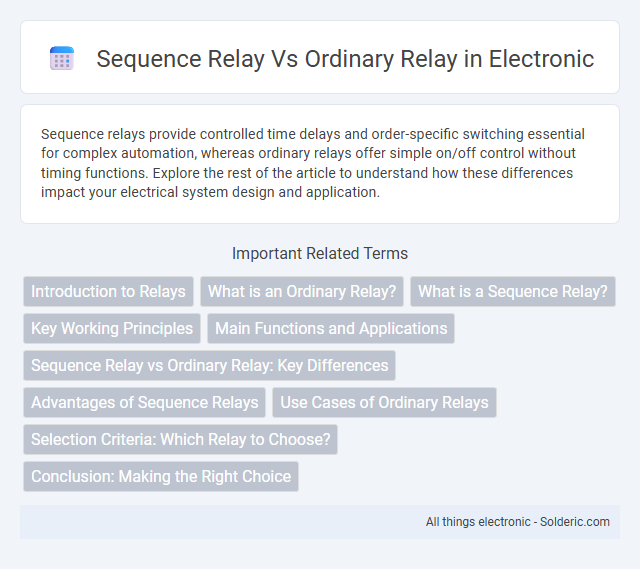Sequence relays provide controlled time delays and order-specific switching essential for complex automation, whereas ordinary relays offer simple on/off control without timing functions. Explore the rest of the article to understand how these differences impact your electrical system design and application.
Comparison Table
| Feature | Sequence Relay | Ordinary Relay |
|---|---|---|
| Function | Operates in a specific sequence based on input signals | Activates immediately upon receiving a control signal |
| Application | Used in automated processes requiring timed operations | Used for basic switching operations in electrical circuits |
| Complexity | More complex, designed for sequential control | Simple, designed for on/off switching |
| Control | Depends on multiple inputs and order of activation | Depends on a single input signal |
| Example Uses | Industrial automation, conveyor systems | Lighting control, motor starters |
| Response Time | May involve delay for sequence confirmation | Immediate response to input |
| Cost | Typically higher due to added functionality | Generally lower and widely available |
Introduction to Relays
Sequence relays control the operation of electrical circuits by activating outputs in a predetermined order, ensuring process safety and timing accuracy. Ordinary relays provide simple on/off switching functions without sequential control, primarily used for basic circuit isolation and control. Sequence relays enhance automation and fault detection in complex systems, while ordinary relays serve general switching applications.
What is an Ordinary Relay?
An ordinary relay is an electromechanical switch used to control a high-power circuit with a low-power signal by opening or closing contacts through an electromagnetic coil. It operates based on a single input signal, providing basic on-off control without any predetermined sequence or logic. These relays are commonly used in simple control applications where sequence control or interlocking is not required.
What is a Sequence Relay?
A Sequence Relay is a specialized electromechanical device designed to control the sequential operation of electrical circuits by ensuring each step occurs in a predetermined order. Unlike an Ordinary Relay, which simply opens or closes contacts based on a single input, a Sequence Relay manages multiple contacts and inputs to coordinate complex processes like motor starting or industrial automation. Your system benefits from improved safety and reliability when using a Sequence Relay to prevent operations from occurring out of sequence.
Key Working Principles
Sequence relays operate based on the predefined order of input signals, ensuring specific operations occur only after certain conditions are met in a sequence, using logic-based contacts to control output circuits. Ordinary relays function by directly responding to an input electrical signal to open or close contacts, providing simple on/off switching without considering the order or timing of inputs. Sequence relays are ideal for automation processes requiring stepwise control, while ordinary relays serve basic electrical isolation and control tasks.
Main Functions and Applications
Sequence relays are designed to control operations in a specific order, ensuring that electrical circuits are energized sequentially to prevent malfunctions in complex machinery. Ordinary relays primarily serve as simple on/off switches, used for basic control functions like turning devices or circuits on and off based on certain input signals. Sequence relays find applications in industrial automation, conveyor systems, and motor control where precise timing is critical, while ordinary relays are widely used in household appliances, automotive systems, and general electrical circuits.
Sequence Relay vs Ordinary Relay: Key Differences
Sequence relays operate based on predetermined logic sequences to control the order of electrical operations, while ordinary relays function as simple electromagnetic switches without built-in logic. Sequence relays provide enhanced control in complex automation systems by ensuring specific event sequences, unlike ordinary relays which respond solely to input signals. The key difference lies in sequence relays' capability to manage multi-step processes, making them essential for industrial applications requiring precise operational order.
Advantages of Sequence Relays
Sequence relays offer enhanced control for complex automation tasks by enabling precise timing and coordination of multiple operations, which ordinary relays cannot achieve. Their ability to handle sequential switching improves system reliability and reduces the risk of operational errors, making them invaluable in industrial process control. You benefit from increased efficiency and safer machinery performance when opting for sequence relays over ordinary relays.
Use Cases of Ordinary Relays
Ordinary relays are widely used in applications such as motor control, lighting systems, and simple automation tasks where on/off switching is required without complex logic sequencing. They are ideal for electrically isolating control circuits from high-power loads and provide reliable switching in household appliances, automotive systems, and industrial machinery. Their straightforward design allows easy integration into control panels for basic switching operations.
Selection Criteria: Which Relay to Choose?
When selecting between a sequence relay and an ordinary relay, consider the complexity of your control logic, as sequence relays are ideal for managing multiple timed operations in a specific order, enhancing automation precision. Ordinary relays are more suitable for simpler on/off control applications where single switching actions suffice, offering cost-effectiveness and straightforward installation. Your choice should align with the required operational sequence, timing accuracy, and system complexity to ensure optimal performance and reliability.
Conclusion: Making the Right Choice
Sequence relays offer precise control for complex operations by allowing multiple outputs to activate in a predefined order, enhancing system reliability and safety compared to ordinary relays. Ordinary relays are simpler and more cost-effective for basic on/off control but lack the advanced timing features needed for intricate processes. Your choice depends on the application complexity and the need for staged operation, with sequence relays being ideal for sequential control tasks and ordinary relays suitable for straightforward switching.
Sequence Relay vs Ordinary Relay Infographic

 solderic.com
solderic.com